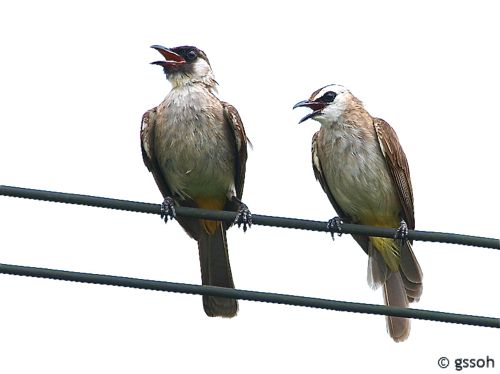GS Soh was observing a pair of bulbuls – a Sooty-headed (Pycnonotus aurigaster) (below, on the left) and a Yellow-vented (P. goiavier) (below, on the right). The calls of the two species are different, yet they interact well. Whenever the Sooty-headed called, the Yellow-vented would appear. “Can a species of bird understand the call of another?” asked GS.
John Vickerman, our bird behaviourist, has this to say: “Yes, definitely birds can and do respond to calls and songs of different species. Alarm calls, e.g. given when a bird of prey is around, will send small birds of all sorts of species scurrying for cover very quickly. So alarm calls of many species are readily understood by other bird species.
“I don’t know enough about the similarity, or otherwise, of the songs of these two species of bulbul, but since they are fairly closely related, and the songs of most bulbuls consist of a wide variety of melodic content, I would assume that there is some acceptance between these two birds of each other’s songs which, though unusual, has led to the “pairing” of these two birds.
“Breeding success rates of hybrid pairs are nearly always much lower than of same species pairings, and hybrid birds are often infertile or are not selected for further breeding attempts. Wildfowl, game birds and some finches are a bit of an exception here there being all sorts of peculiar “Heinz 57” mixtures largely resulting from farmed or caged breeding. Such occurrences in the wild though happen much less frequently.”
Our bird specialist, R Subaraj adds: “The Yellow-vented Bulbul has seemingly paired off with a Sooty-headed Bulbul. The latter has a feral population in Singapore, which is presently confined to N.E. Singapore, particularly from Pasir Ris to Seletar Camp (including Lorong Halus area). However, fresh escapees have been encountered in various other areas over the years.
“The Sooty-headed Bulbul has either a red or yellow vent, depending on the race. The Singapore feral population is claimed to be of the race P. a. aurigaster (Robson (2008). However, we cannot rule out escapees of the other yellow-vented races (P. a. thais and P. a. germani). [Escapes with red vents have also been recorded in Singapore.]
“A most interesting record. Curious that both have yellow vents… was that the attraction?”
Image by GS Soh.
Reference:
Robson, C., 2008. A field guide to the birds of South-east Asia. New Holland, London. 544 pp.
This post is a cooperative effort between NaturePixels.org and BESG to bring the study of bird behaviour through photography to a wider audience.










8 Responses
Very interesting record. I have been tracking the Sooties in the Tampines – Pasir Ris Area since year 2000.
How about a short account of your observations for the blog, John?
As the other commentators have noted, birds of related species do interact, whether for social or aggressive reasons. The interaction between a Great Indian and a Rhinoceres Hornbill in the Bukit Timah area has been documented by many contributors to this site.
You will also note that in the feral populations of cockatoos in Singapore, due to the small numbers, these normally very social birds will form mixed-species flocks. In aviculture, hybridization has been recorded.
Specimens of the commonly kept collared dove (a Streptopelia hybrid of mixed ancestry, probably with S. decactao predominating) which are often released at weddings and religious ceremonies, do pair up with the spotted dove (Streptopelia chinensis).
On the aggression front, magpie robins (Copsychus saularis) react very fiercely to shamas (Copsychus malabaricus) in their territories.
Before the Singapore population of magpie robins was decimated by poachers, keepers of imported shamas often had their birds badly intimidated by free-flying specimens of the larger local yokels who would peck them through cage bars.
Lee Chiu San